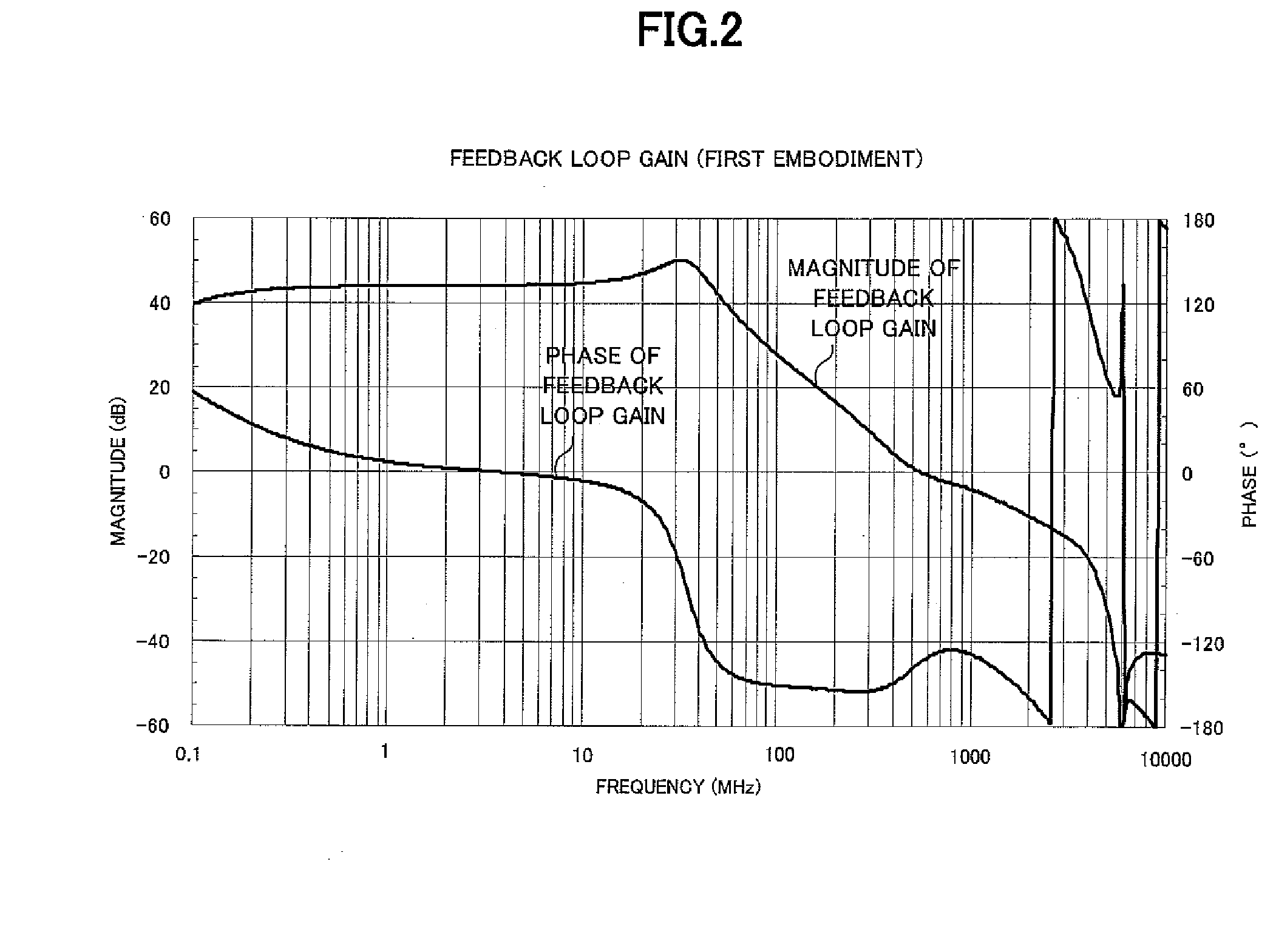Low noise amplifier and differential amplifier
- Summary
- Abstract
- Description
- Claims
- Application Information
AI Technical Summary
Benefits of technology
Problems solved by technology
Method used
Image
Examples
first embodiment
[0095]FIG. 1 is a circuit diagram showing a TFC-LNA 20 according to the first embodiment of the invention.
[0096]A 10-V direct-current supply voltage Vd1 is applied to the TFC-LNA 20 from a direct-current voltage source DCS, and transistors each of which has a transient frequency of 8 GHz are used.
[0097]A signal source 21 having an output impedance R of 50Ω is connected to the hot side of the primary winding of a transformer 23 through a coupling capacitor 22. A commercially-available transformer whose turn ratio is 1:2 is used as the transformer 23.
[0098]The cold side of the primary winding of the transformer 23 is connected to the base of an NPN transistor 24 which serves as an input-stage transistor of a cascode connection. The base of the transistor 24 is further connected to the positive electrode of a biasing voltage source 25 through a choke coil 26.
[0099]The collector of the transistor 24 is connected to the emitter of an NPN transistor 27 which serves as an upper-stage trans...
second embodiment
[0134]FIG. 7 is a circuit diagram showing a TFC-LNA 50 according to the second embodiment of the invention.
[0135]In the TFC-LNA 50 of the embodiment, the direct-current source 39 of the first embodiment is replaced with a variable current source 51, and the collector of emitter follower transistor 31 is connected to a variable voltage source DCS2 having Vd2 as its output voltage, instead of the voltage source DCS1. Every other structural portion remains same as those of the TFC-LNA 20 of the first embodiment.
[0136]According to the TFC-LNA 20 of the first embodiment, an operating current of about 12 mA is applied to the emitter follower which is the output buffer of the TFC-LNA 20 because of the necessity of realizing a high dynamic range. Because the 10-V direct-current supply voltage Vd1 is applied to the TFC-LNA 20, the output buffer consumes power of 120 mW. Such a 120-mW power consumption is small in comparison with the overall power consumption of a fixed radio device, so that ...
third embodiment
[0157]FIG. 12 is a diagram showing a TFC-LNA 60 according to the third embodiment of the invention.
[0158]The TFC-LNA 60 of this embodiment is equivalent to the TFC-LNA 20 of the first embodiment where the transistor 31, constituting the emitter follower, the transistors 35, 37, and 38, constituting the current mirror, the resistors 36, 40, and the current source 39 are eliminated, and the collector of the transistor 27, i.e., the output node of the cascode amplifier is caused to directly function as the output terminal of the TFC-LNA 60. The output terminal of the TFC-LNA 60 is connected to an output load 33 through a coupling capacitor 32, and is further connected to the secondary winding of the transformer 23, which constitutes a first negative feedback path, through the coupling capacitor 34, and to the resistor 44, which constitutes a second negative feedback path, through the coupling capacitor 41. The other structural portions of the TFC-LNA 60 are same as those of the TFC-LNA...
PUM
 Login to View More
Login to View More Abstract
Description
Claims
Application Information
 Login to View More
Login to View More - R&D
- Intellectual Property
- Life Sciences
- Materials
- Tech Scout
- Unparalleled Data Quality
- Higher Quality Content
- 60% Fewer Hallucinations
Browse by: Latest US Patents, China's latest patents, Technical Efficacy Thesaurus, Application Domain, Technology Topic, Popular Technical Reports.
© 2025 PatSnap. All rights reserved.Legal|Privacy policy|Modern Slavery Act Transparency Statement|Sitemap|About US| Contact US: help@patsnap.com



